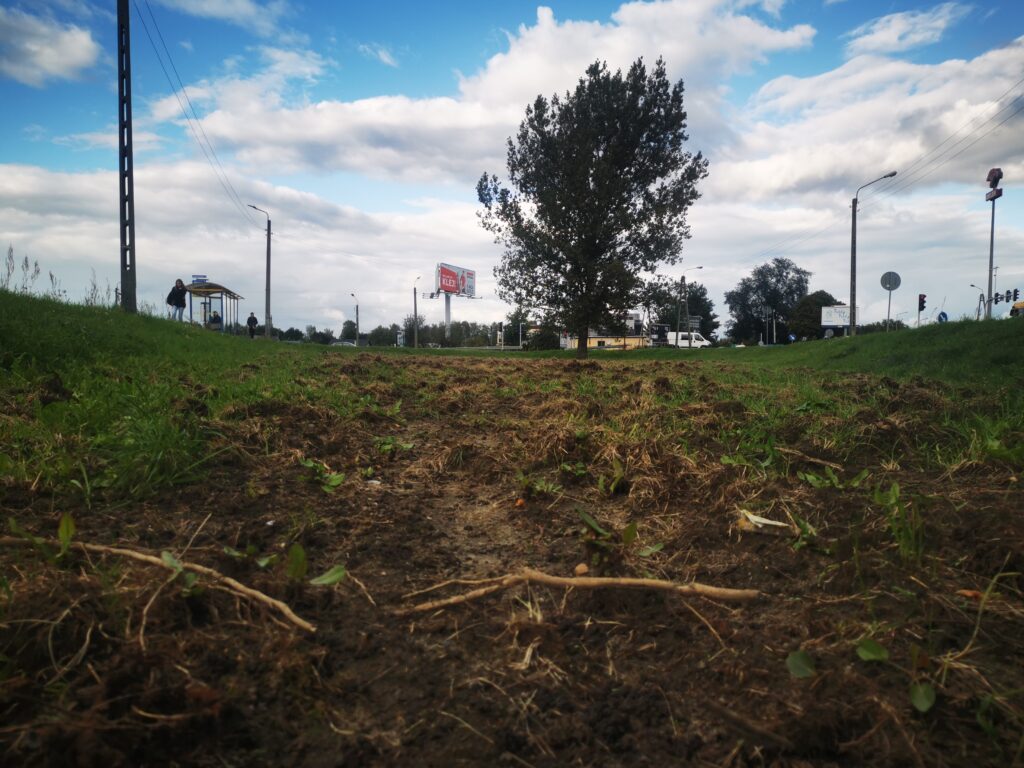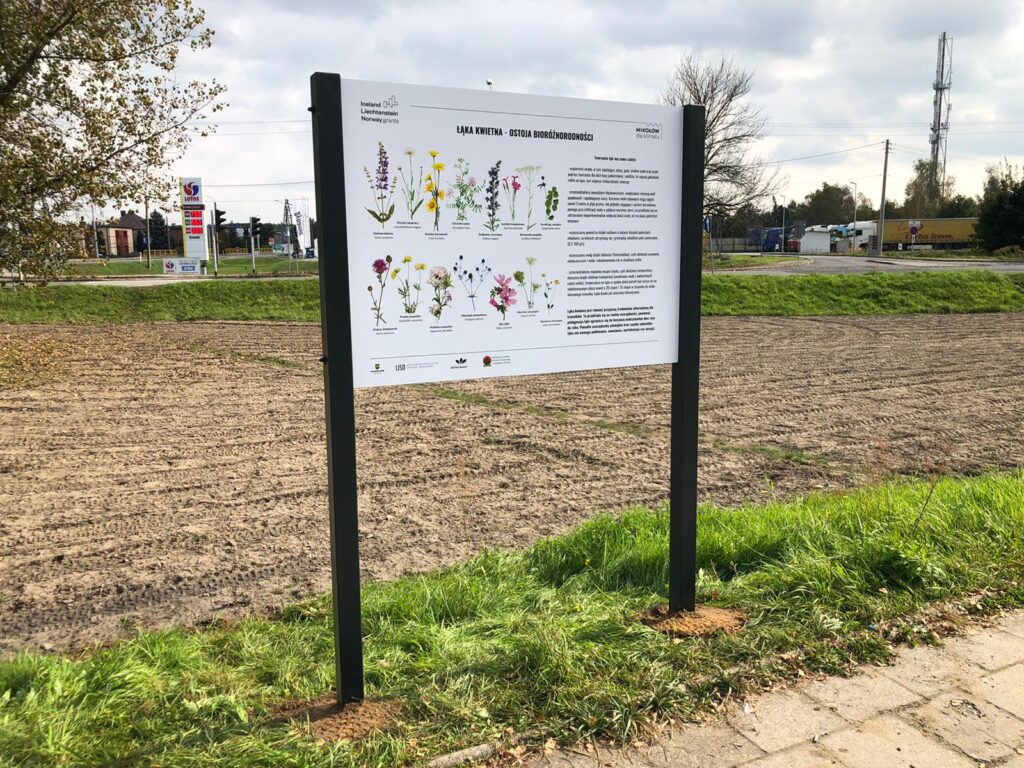The first completed investment is a flower meadow, which was established at the junction of Przelotowa and Gliwicka Streets. The area designated for this purpose covers an area of 1,600 m2. As part of the preparatory work, the area was examined to determine the pH, mineral content and soil type. On this basis, the composition of the seed mix was determined, also taking into account factors such as the target height of the plants (no more than 90 cm so as not to restrict the field of vision for traffic users) or the season and length of flowering. The species selected include mainly native perennials. Before sowing, the land was ploughed and tidied up and levelled. Sowing was done in early autumn. We look forward to spring and summer to admire the result!
This is how the site looked after the investment work had started:


After sowing:


Content of the information board:

Flower meadow – an alternative to lawn
Many garden owners make it a point of honour to be the owner of the most manicured lawn in the neighbourhood – always low cut, without any ‘intruders’ such as clover, daisies or dandelions. They spend a lot of time and money on this. Fortunately, more and more people want to run their garden in harmony with nature, without fighting it at every turn. Flower meadows are a very good alternative to lawns. Contrary to what you might think, you don’t need a hectare of land to create such a meadow in your garden. It can even be a few square metres. The actual preparation for sowing a meadow will not take up much time, while the time spent on mowing (tens or even hundreds of hours a year) can be used to relax in a hammock and admire the pollinators working in our meadow.
More and more seed mixtures for flower meadows are appearing on the market, but we must be careful when choosing. Unfortunately, some manufacturers (especially the seeds available in DIY stores) add seeds of species alien to our flora and even invasive species to the composition! For amateur gardeners wishing to set up a flower meadow, we recommend the book Dziki Ogród, authored by Łukasz Łuczaj, Ph.D., professor at the University of Rzeszów. It contains valuable, practical advice on establishing and caring for meadows, as well as other ways to increase biodiversity in the garden.
First steps: land preparation
The best method for establishing a meadow is to sow a mixture into clean soil (previously dug or ploughed and cleared of plants), it is good if the area can be heaped after this procedure. If a meadow is to be created in a place where there was previously a low lawn, there is no need to carry out deep ploughing – a soil tiller or manual digging will suffice. You can also cover the area for sowing with black plastic sheeting or matting for the whole summer season. This should be removed in September and the sowing done then. Soil disturbance unfortunately brings plant seeds from the soil seed bank to the surface, very common among them are seeds of undesirable species. They have been in the soil deeper and have waited up to several decades for conditions to germinate. However, we do not recommend treating the area with herbicides to ‘burn out’ all life before sowing. These substances stay in the soil for years, their use has negative effects on our health and the environment. Instead, the mixture can be sown a little more densely (2-3 grams per square metre), and who knows, maybe the soil seed bank will surprise us with some interesting species. If you are sowing a perennial meadow, you can also mow it several times in the first year. This will get rid of the annual weeds and allow the perennial plants to develop.
Choice of species
Good quality and interesting species mixes are best bought online. It is very important that the producer indicates the species composition on the package. Ideally, there should be no “filler” grass species in the mix – this makes the mix cheaper to produce and more profitable, but for us it means a lot fewer flowering species in the meadow. It is important to consider whether you want to buy a mixture which includes field poppy or cornflower – they require annual digging of the soil in order to grow and bloom (this is why they appear in cultivated fields). After using such a mix, unfortunately we will only enjoy them in the first year after sowing. It is best to check each species listed in the mix – whether it is perennial or annual, native, invasive or perhaps only grown in gardens. Producers of market mixes often promise a meadow of wildflowers, when in fact most of the seeds in the mix are alien garden species.
Collecting seeds
For keen individuals who are a little familiar with the species, it will be good and rewarding to collect the seeds yourself. There are also emerging online forums and thematic groups for people to exchange seeds. If you live out of town and have meadows nearby, collecting seeds should not be a problem. For some species, it is convenient to collect the seeds or fruit themselves, sometimes the whole heads are peeled off. All you need for this is a bucket or a bag, such as one made of cotton. Ideally, we can go into the field from July until the first frost, because species produce seeds at different times of the year, so if you want to have a lot of species in your mix, it is worth taking some time to harvest. With many species, it’s easy to miss the moment of harvest and find only empty seed coats, so if you’re particularly keen on a particular species, it’s worth going out into the field a few times to inspect the plants, which in itself is a very pleasant activity.
In most cases, the harvested seeds need to be dried, especially if you are cutting whole stems. It is best to spread the harvest in a very thin layer on cardboard or newspaper in an airy attic. It is difficult to dry seeds in a flat, as at least two windows should always be open. You will prolong the life of the seeds by keeping them in a cool and airy place. Most meadow and field plants retain their germination strength for at least a year, but it is best to sow seeds up to two years after harvesting. Many meadow species germinate a few weeks after sowing, but some require stratification, i.e. storage at around 4 degrees Celsius for several weeks. The best way to do this is to place the dried seeds in a ziplock bag in the fridge.
Care
Perennial (permanent) meadows are usually mown twice a year. The first mowing should be done in June or July, the second in August or September. For an interesting mosaic of species, half of the meadow can be mown in June and the other half in the summer, and the same can be done in autumn. Annual meadows, on the other hand, are mown once a year, after the flowers have flowered. The cuttings should be left in the meadow so that the seeds spill into the soil. In order for the plants to flower the following year, the land needs to be dug up to recreate the natural cycle of the fields where the field flowers come from. Keep this in mind when choosing a seed mix, as digging up a meadow every year is already a time-consuming task. Leave the hay in the meadow for a few days, until the seeds dry out and settle, which will provide a seed bank for the development of new plants. Leaving the hay will also give insects and other meadow-dwelling organisms a chance to leave the plants. It is best to use a traditional scythe or a slatted mower for mowing. Mow at a height of 8-10 cm. Mowing at a lower height may damage the leaf rosettes of the perennial plants. Watering the meadow is only needed in the first year if sowing was in spring. Flowering plants have a much higher drought tolerance than common grass species. A flowering meadow can survive water deficits, which are deadly for lawns. Watering is only recommended in very dry conditions, when we see that our meadow will not be able to survive without intervention.






